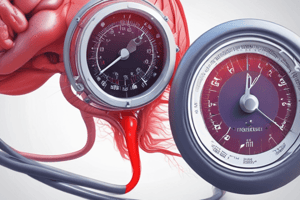Podcast
Questions and Answers
किस आयु में लड़कियों के लिए वृद्धि शैथिल्य की शुरुआत सामान्य रूप से होती है?
किस आयु में लड़कियों के लिए वृद्धि शैथिल्य की शुरुआत सामान्य रूप से होती है?
11-12 वर्ष
किसकी धरोहर विकास के लिए वृद्धि शैथिल्य जिम्मेदार है?
किसकी धरोहर विकास के लिए वृद्धि शैथिल्य जिम्मेदार है?
ग्रोथ हार्मोन
किस वयाक लिंग के लिए वृद्धि शैथिल्य की शुरुआत सामान्य रूप से होती है?
किस वयाक लिंग के लिए वृद्धि शैथिल्य की शुरुआत सामान्य रूप से होती है?
13-14 वर्ष
किस यौवन में हार्मोन की उच्चता वृद्धि शैथिल्य की शुरुआत करती है?
किस यौवन में हार्मोन की उच्चता वृद्धि शैथिल्य की शुरुआत करती है?
किस युवावस्था में किशोरों के शारीरिक परिवर्तनों के साथ कई शारीरिक परिवर्तन हो सकते हैं?
किस युवावस्था में किशोरों के शारीरिक परिवर्तनों के साथ कई शारीरिक परिवर्तन हो सकते हैं?
लड़कियों के लिए विलंबकालीन किशोरावस्था में क्या शारीरिक परिवर्तन हो सकते हैं?
लड़कियों के लिए विलंबकालीन किशोरावस्था में क्या शारीरिक परिवर्तन हो सकते हैं?
किस युवा वयाक के दौरान पुरुषों का वाणी परिवर्तन होता है?
किस युवा वयाक के दौरान पुरुषों का वाणी परिवर्तन होता है?
किसके द्वारा थायरॉइड हार्मोन उत्पन्न होते हैं और क्या कार्य करते हैं?
किसके द्वारा थायरॉइड हार्मोन उत्पन्न होते हैं और क्या कार्य करते हैं?
विलंबकालीन किशोरावस्था में कौन-कौन से कारक शारीरिक परिवर्तनों को प्रभावित कर सकते हैं?
विलंबकालीन किशोरावस्था में कौन-कौन से कारक शारीरिक परिवर्तनों को प्रभावित कर सकते हैं?
पुरुषों के लिए विलंबकालीन किशोरावस्था में किस तरह के शारीरिक परिवर्तन हो सकते हैं?
पुरुषों के लिए विलंबकालीन किशोरावस्था में किस तरह के शारीरिक परिवर्तन हो सकते हैं?
Flashcards are hidden until you start studying
Study Notes
Hormonal Shifts After Turning 14
As we transition into adolescence, our bodies undergo a remarkable transformation fueled by hormones. Although the primary stages of puberty typically begin around 10-12 years of age, the timing and pace of hormonal changes can vary among individuals. In this article, we'll delve into how hormone regulation, puberty changes, growth spurts, emotional shifts, and physical developments unfold in the teenage years following the age of 14.
Hormone Regulation
Hormones are chemical messengers that help regulate the various systems of our body, including development, growth, and reproduction. The two primary hormones responsible for puberty are gonadotropin-releasing hormone (GnRH) and the sex hormones, estrogen in females and testosterone in males. GnRH is produced by the hypothalamus and stimulates the pituitary gland to secrete luteinizing hormone (LH) and follicle-stimulating hormone (FSH). These hormones in turn regulate the production of estrogen and testosterone, which drive the changes we experience during adolescence.
Puberty Changes
Adolescent development involves the maturation of the reproductive system and a multitude of physical and emotional changes. In males, puberty typically includes a growth spurt, followed by the development of facial hair, deepening of the voice, and the appearance of secondary sexual characteristics, such as broader shoulders and increased muscle mass. In females, puberty involves breast development, the growth of pubic and underarm hair, and the appearance of secondary sexual characteristics, such as wider hips and increased body fat.
Growth Spurt Timing
The timing of the growth spurt can vary widely, with some individuals beginning earlier and others later. The average age for the onset of the growth spurt is roughly 11-12 years for girls and 13-14 years for boys. In some cases, growth spurts may occur even later, up until the age of 14 or 15 years. The growth spurt is initiated by a surge in growth hormone (GH) secretion, which supports the rapid growth of bones and muscles during adolescence.
Emotional Changes
Adolescence is often accompanied by profound emotional changes. As hormones fluctuate, teens may experience mood swings, increased sensitivity, and changes in behavior. The brain also undergoes significant development during adolescence, and these changes may lead to feelings of anxiety, stress, and insecurity. Some teens may struggle with mental health challenges, such as depression and anxiety, during this time.
Physical Changes
Beyond the development of secondary sexual characteristics, growth spurts, and changes in body shape, adolescents may experience a variety of physical changes. Some of these include increased body odor, oily skin, changes in vision and hearing, and a greater susceptibility to illness and injury. As teens grapple with these changes, they may feel a heightened sense of self-consciousness and self-awareness.
In summary, the hormonal changes that occur after the age of 14 play a crucial role in driving the physical, emotional, and mental transformations that define adolescence. As teens navigate these shifts, it's essential to provide them with accurate information, support, and empathy, to help them successfully navigate this challenging yet exciting time of their lives.
Studying That Suits You
Use AI to generate personalized quizzes and flashcards to suit your learning preferences.




